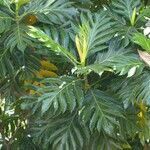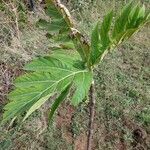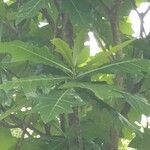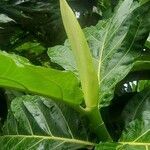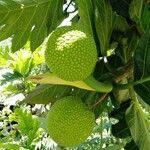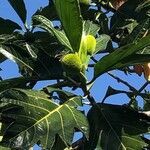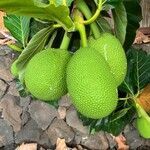A large tree up to 20-26 m in height. The trunk can be 6 m tall before branching. The trunk can be up to 1 m across. It is an evergreen tree but can lose its leaves in dry weather. The leaves are large and vary in the amount the leaves are divided. They can be entire or divided into 5 to 11 lobes. The leaves are bright green on the upper surface with yellow veins and are pale and dull on the under surface. They have very small stiff hairs underneath. Male and female flowers occur on the same tree. The male flowers are cylindrical spikes which droop and are 12-30 cm long. The female flowers are grouped in a round head. The flower head develops into the compound fruit. The fruit are large and green. They can be 20 cm across. Seeded kinds have spines, and seedless kinds have a more smooth surface. Seeded, small seeded, and non seeded types occur. There are a number of cultivars of each. Seed can be 2 cm across and with darker lines.
Tree up to 35 m tall. Stipules 10-25 cm long; blade pinnately incised, elliptic, up to 50 x 20 cm. Inflorescences in the leaf axils. Staminate inflorescences cylindrical to clavate, 10-30 cm long. Pistillate inflorescences ellipsoid to globose, in fruit 15-30 cm in diam., covered with conical processes or (in the seedless form) rather smooth.
Tree.. Lamina mostly ± 30–50 × 15–20 cm., pinnately incised.. Inflorescences in the leaf-axils.
A hybrid between breadfruit and dugdug.
Pending.
